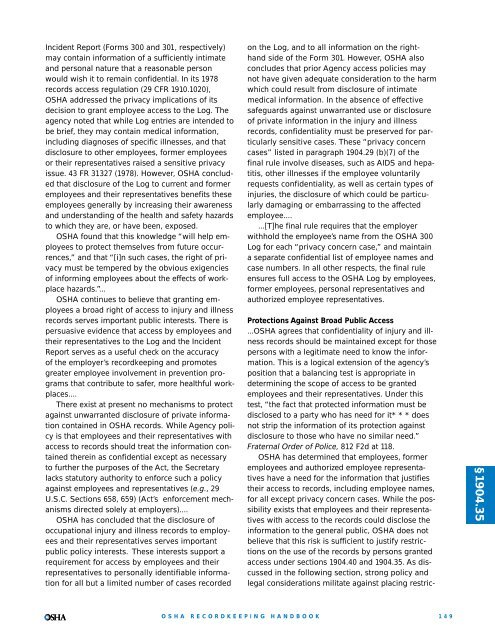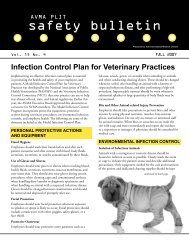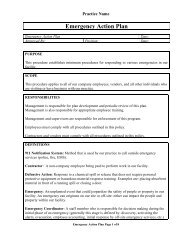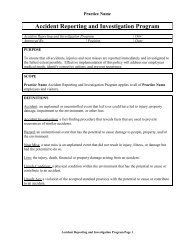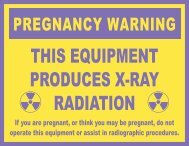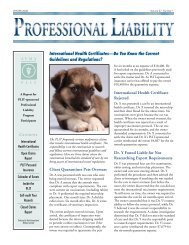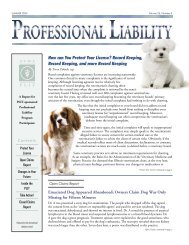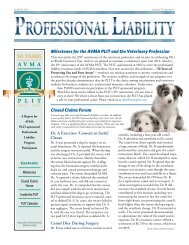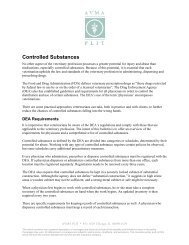§1904.351904 regulation to provide limited access to the<strong>OSHA</strong> recordkeeping forms to current and formeremployees, as well as to two types of employeerepresentatives. The first is a personal representativeof an employee or former employee, who is aperson that the employee or former employee designates,in writing, as his or her personal representative,or is the legal representative of a deceasedor legally incapacitated employee or former employee.The second is an authorized employee representative,which is defined as an authorized collectivebargaining agent of one or more employeesworking at the employer’s establishment.Section 1904.35 accords employees and theirrepresentatives three separate access rights. First,it gives any employee, former employee, personalrepresentative, or authorized employee representativethe right to a copy of the current <strong>OSHA</strong> 300Log, and to any stored <strong>OSHA</strong> 30 log(s), for anyestablishment in which the employee or formeremployee has worked. The employer must provideone free copy of the <strong>OSHA</strong> 300 Log(s) by the end ofthe next business day. The employee, formeremployee, personal representative or authorizedemployee representative is not entitled to see, or toobtain a copy of, the confidential list of names andcase numbers for privacy cases. Second, anyemployee, former employee, or personal representativeis entitled to one free copy of the <strong>OSHA</strong> 301Incident Report describing an injury or illness tothat employee by the end of the next business day.Finally, an authorized employee representative isentitled to copies of the right-hand portion of all<strong>OSHA</strong> 301 forms for the establishment(s) where theagent represents one or more employees under acollective bargaining agreement. The right-handportion of the 301 form contains the heading[“Information about the case,”] and elicits informationabout how the injury occurred, including theemployee’s actions just prior to the incident, thematerials and tools involved, and how the incidentoccurred, but does not contain the employee’sname. No information other than that on the righthandportion of the form may be disclosed to anauthorized employee representative. The employermust provide the authorized employee representativewith one free copy of all the 301 forms for theestablishment within 7 calendar days.Employee privacy is protected in the final rule inparagraphs 1904.29(b)(7) to (10). Paragraph1904.29(b)(7) requires the employer to enter thewords “privacy case” on the <strong>OSHA</strong> 300 Log, in lieuof the employee’s name, for recordable privacyconcern cases involving the following types ofinjuries and illnesses: (i) an injury from a needle orsharp object contaminated by another person’sblood or other potentially infectious material; (ii) aninjury or illness to an intimate body part or to thereproductive system; (iii) an injury or illness resultingfrom a sexual assault; (iv) a mental illness; (v)an illness involving HIV, hepatitis; or tuberculosis,or (vi) any other illness, if the employee independentlyand voluntarily requests that his or her namenot be entered on the log....The employer may take additional action in privacyconcern cases if warranted. Paragraph1904.29(b)(9) allows the employer to use discretionin describing the nature of the injury or illness in aprivacy concern case, if the employer has a reasonablebasis to believe that the injured or ill employeemay be identified from the records even thoughthe employee’s name has been removed. Only thesix types of injuries and illnesses listed in Paragraph1904.29(b)(7) may be considered privacyconcern cases, and thus the additional protectionoffered by paragraph 1904.29(b)(9) applies only tosuch cases.Paragraph 1904.29(b)(10) protects employee privacyif the employer decides voluntarily to disclosethe <strong>OSHA</strong> 300 and 301 forms to persons other thanthose who have a mandatory right of access underthe final rule. The paragraph requires the employerto remove or hide employees’ names or other personallyidentifying information before disclosingthe forms to persons other than government representatives,em-ployees, former employees orauthorized representatives, as required by paragraphs1904.40 and 1904.35, except in three cases.The employer may disclose the forms, completewith personally identifying information, [ ] only: (i)to an auditor or consultant hired by the employerto evaluate the safety and health program; (ii) tothe extent necessary for processing a claim forworkers’ compensation or other insurance benefits;or (iii) to a public health authority or law enforcementagency for uses and disclosures for whichconsent, an authorization, or opportunity to agreeor object is not required under section 164.512of the final rule on Standards for Privacy of IndividuallyIdentifiable Health Information, 45 CFR164.512....Balancing the Interests of Privacy and Access<strong>OSHA</strong> historically has recognized that the Log and148<strong>OSHA</strong> RECORDKEEPINGHANDBOOK
Incident Report (Forms 300 and 301, respectively)may contain information of a sufficiently intimateand personal nature that a reasonable personwould wish it to remain confidential. In its 1978records access regulation (29 CFR 1910.1020),<strong>OSHA</strong> addressed the privacy implications of itsdecision to grant employee access to the Log. Theagency noted that while Log entries are intended tobe brief, they may contain medical information,including diagnoses of specific illnesses, and thatdisclosure to other employees, former employeesor their representatives raised a sensitive privacyissue. 43 FR 31327 (1978). However, <strong>OSHA</strong> concludedthat disclosure of the Log to current and formeremployees and their representatives benefits theseemployees generally by increasing their awarenessand understanding of the health and safety hazardsto which they are, or have been, exposed.<strong>OSHA</strong> found that this knowledge “will help employeesto protect themselves from future occurrences,”and that “[i]n such cases, the right of privacymust be tempered by the obvious exigenciesof informing employees about the effects of workplacehazards.”...<strong>OSHA</strong> continues to believe that granting employeesa broad right of access to injury and illnessrecords serves important public interests. There ispersuasive evidence that access by employees andtheir representatives to the Log and the IncidentReport serves as a useful check on the accuracyof the employer’s recordkeeping and promotesgreater employee involvement in prevention programsthat contribute to safer, more healthful workplaces....There exist at present no mechanisms to protectagainst unwarranted disclosure of private informationcontained in <strong>OSHA</strong> records. While Agency policyis that employees and their representatives withaccess to records should treat the information containedtherein as confidential except as necessaryto further the purposes of the Act, the Secretarylacks statutory authority to enforce such a policyagainst employees and representatives (e.g., 29U.S.C. Sections 658, 659) (Act’s enforcement mechanismsdirected solely at employers)....<strong>OSHA</strong> has concluded that the disclosure ofoccupational injury and illness records to employeesand their representatives serves importantpublic policy interests. These interests support arequirement for access by employees and theirrepresentatives to personally identifiable informationfor all but a limited number of cases recordedon the Log, and to all information on the righthandside of the Form 301. However, <strong>OSHA</strong> alsoconcludes that prior Agency access policies maynot have given adequate consideration to the harmwhich could result from disclosure of intimatemedical information. In the absence of effectivesafeguards against unwarranted use or disclosureof private information in the injury and illnessrecords, confidentiality must be preserved for particularlysensitive cases. These “privacy concerncases” listed in paragraph 1904.29 (b)(7) of thefinal rule involve diseases, such as AIDS and hepatitis,other illnesses if the employee voluntarilyrequests confidentiality, as well as certain types ofinjuries, the disclosure of which could be particularlydamaging or embarrassing to the affectedemployee.......[T]he final rule requires that the employerwithhold the employee’s name from the <strong>OSHA</strong> 300Log for each “privacy concern case,” and maintaina separate confidential list of employee names andcase numbers. In all other respects, the final ruleensures full access to the <strong>OSHA</strong> Log by employees,former employees, personal representatives andauthorized employee representatives.Protections Against Broad Public Access...<strong>OSHA</strong> agrees that confidentiality of injury and illnessrecords should be maintained except for thosepersons with a legitimate need to know the information.This is a logical extension of the agency’sposition that a balancing test is appropriate indetermining the scope of access to be grantedemployees and their representatives. Under thistest, “the fact that protected information must bedisclosed to a party who has need for it* * * doesnot strip the information of its protection againstdisclosure to those who have no similar need.”Fraternal Order of Police, 812 F2d at 118.<strong>OSHA</strong> has determined that employees, formeremployees and authorized employee representativeshave a need for the information that justifiestheir access to records, including employee names,for all except privacy concern cases. While the possibilityexists that employees and their representativeswith access to the records could disclose theinformation to the general public, <strong>OSHA</strong> does notbelieve that this risk is sufficient to justify restrictionson the use of the records by persons grantedaccess under sections 1904.40 and 1904.35. As discussedin the following section, strong policy andlegal considerations militate against placing restric-§1904.35<strong>OSHA</strong> RECORDKEEPINGHANDBOOK149
- Page 1 and 2:
www.osha.govOSHARecordkeepingHandbo
- Page 3 and 4:
OSHARecordkeeping HandbookThe Regul
- Page 5 and 6:
ContentsRecordkeeping HandbookRoadm
- Page 7 and 8:
Section 1904.40Providing records to
- Page 10 and 11:
§1904.0…OSHA has rejected the su
- Page 12 and 13:
§1904.1Since publication of the re
- Page 14 and 15:
§1904.2SIC code Industry descripti
- Page 16 and 17:
§1904.2tinue to have injury and il
- Page 18 and 19:
Section 1904.3Keeping records for m
- Page 20 and 21:
PREAMBLE DISCUSSION: Section 1904.4
- Page 22 and 23:
(viii)(ix)The illness is the common
- Page 24 and 25:
§1904.5employment environment. For
- Page 26 and 27:
§1904.5the employee’s status as
- Page 28 and 29:
§1904.5Exceptions Proposed but Not
- Page 30 and 31:
§1904.5pain and swelling in a join
- Page 32 and 33:
§1904.5the worker has taken a side
- Page 34 and 35:
§1904.526“Personal tasks” for
- Page 36 and 37:
If the accident had occurred in a l
- Page 38 and 39:
Scenario 4:• An employee reports
- Page 40 and 41:
In applying [the presumption of wor
- Page 42 and 43:
Letters of interpretation related t
- Page 44 and 45:
November 19, 2002Joseph Woodward, E
- Page 46 and 47:
Letter of interpretation related to
- Page 48 and 49:
§1904.6that the two injuries or il
- Page 50 and 51:
§1904.6…Under the OSHA recordkee
- Page 52 and 53:
FREQUENTLY ASKED QUESTIONS: Section
- Page 54 and 55:
Since the employee was not performi
- Page 56 and 57:
In each of the eight scenarios in y
- Page 58 and 59:
§1904.7other licensed health care
- Page 60 and 61:
§1904.7that eliminates the routine
- Page 62 and 63:
§1904.7pose. This paragraph also s
- Page 64 and 65:
§1904.7Counting Lost Workdays When
- Page 66 and 67:
§1904.7tors to such injuries and i
- Page 68 and 69:
§1904.7This list of first aid trea
- Page 70 and 71:
§1904.7visit to a health care prof
- Page 72 and 73:
§1904.7However, as discussed above
- Page 74 and 75:
§1904.766immediate recording of si
- Page 76 and 77:
§1904.7strength? How is an employe
- Page 78 and 79:
§1904.7or illness. The severity of
- Page 80 and 81:
The first treatment is glue used to
- Page 82 and 83:
Response: The employer would have t
- Page 84 and 85:
Letter of interpretation related to
- Page 86 and 87:
Letter of interpretation related to
- Page 88 and 89:
§1904.8exposure” as these terms
- Page 90 and 91:
ing blood and other potentially inf
- Page 92 and 93:
standard. In some cases employers v
- Page 94 and 95:
PART 1904—[AMENDED] (67 FR 77170,
- Page 96 and 97:
§1904.1088OSHA RECORDKEEPINGcorrec
- Page 98 and 99:
§1904.1090OSHA RECORDKEEPINGAwaren
- Page 100 and 101:
§1904.1092reasonable checks agains
- Page 102 and 103:
§1904.1094determination. Second, t
- Page 104 and 105:
FREQUENTLY ASKED QUESTIONS: Section
- Page 106 and 107: Also, from time to time we update o
- Page 108 and 109: §1904.11Section 1904.11Recording c
- Page 110 and 111: §1904.11of causation applies to th
- Page 112 and 113: §1904.12Thus, the total MSD count
- Page 114 and 115: §1904.12current survey was designe
- Page 116 and 117: §1904.29son’s blood or other pot
- Page 118 and 119: §1904.29cern cases, and the list m
- Page 120 and 121: §1904.29have also been designed to
- Page 122 and 123: §1904.29with that entry and employ
- Page 124 and 125: FREQUENTLY ASKED QUESTIONS: Section
- Page 126 and 127: Section 1904.29(b)(10). In addition
- Page 128 and 129: Section 1904.30Multiple business es
- Page 130 and 131: fest themselves quickly and can be
- Page 132 and 133: §1904.31The term “employee” me
- Page 134 and 135: §1904.31companies, and other tempo
- Page 136 and 137: Letter of interpretation related to
- Page 138 and 139: Scenario 5:• An employee drives i
- Page 140 and 141: Response: The log is to be kept for
- Page 142 and 143: Section 1904.32Annual summary(66 FR
- Page 144 and 145: §1904.32The company executive cert
- Page 146 and 147: Deletions from the former rule....F
- Page 148 and 149: I do want to make one further point
- Page 150 and 151: sede any longer retention periods s
- Page 152 and 153: Response: The controlling employer
- Page 154 and 155: Section 1904.35Employee involvement
- Page 158 and 159: §1904.35tions on employees’ and
- Page 160 and 161: employee, the employer must provide
- Page 162 and 163: Thank you for your interest in occu
- Page 164 and 165: Letter of interpretation related to
- Page 166 and 167: Section 1904.36Prohibition against
- Page 168 and 169: and section 1952.4 spells out the r
- Page 170 and 171: §1904.38Section 1904.38Variances f
- Page 172 and 173: §1904.38cited and the citation is
- Page 174 and 175: §1904.39PREAMBLE DISCUSSION: Secti
- Page 176 and 177: §1904.39FREQUENTLY ASKED QUESTIONS
- Page 178 and 179: §1904.40maintains the records at a
- Page 180 and 181: June 23, 2003Mr. Edwin G. Foulke, J
- Page 182 and 183: Section 1904.41Annual OSHA injury a
- Page 184 and 185: Section 1904.42Requests from the Bu
- Page 186 and 187: Section 1904.43Summary and posting
- Page 188 and 189: Section 1904.44Retention and updati
- Page 190 and 191: Section 1904.45OMB control numbers
- Page 192 and 193: allows him or her to independently
- Page 194 and 195: §1904.46the three criteria above,
- Page 196 and 197: §1904.46approach will provide an i
- Page 198 and 199: FREQUENTLY ASKED QUESTIONS: Section
- Page 200 and 201: Section 1952.4Injury and illness re


